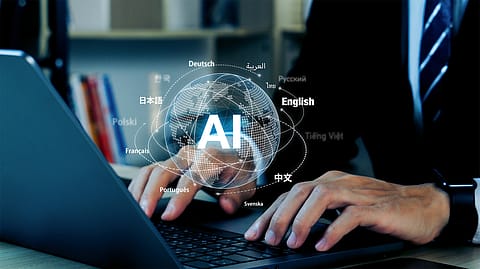How LLMs are powering the next wave of business transformation
More efficient LLMs will continue reducing computational costs, while agentic systems will handle increasingly complex processes

Until recently, the limitations of computation capabilities restricted how far organisations could experiment with AI across business applications. The emergence of Large Language Models (LLMs) has changed that reality, democratising access to AI.
Democratising AI isn't just about making technology accessible; it's about unlocking human potential and breaking traditional barriers. It means enabling a small financial services firm to compete through personalised investment advice, allowing a regional hospital to deploy diagnostic tools that save lives, and reducing dependence on niche talent by empowering employees across departments to harness advanced analytics simply by interacting in natural language. Nearly 78% of companies now use AI in at least one business function, reflecting a shift in what's possible.
Natural language as the equaliser
LLMs have empowered organisations to experiment in ways that were once out of reach due to AI’s steep learning curves and high dependence on niche technical skills. By providing pre-trained models that users can interact with in natural language, they've democratised access and fueled organisation-wide innovation.
Today, a product manager can instantly get market sentiment from emails, reports, and customer communications without waiting for BI specialists. Marketing teams can automate personalised ad copy, predict customer responses, and perform sentiment analysis to optimise targeting, all without AI expertise. Smaller financial firms can deploy fraud detection systems that analyse transactions in real-time. Healthcare organisations can leverage AI-powered diagnostics and virtual health assistants to provide 24/7 patient support.
Integration with hyperscalers has also redefined responsible innovation. Organisations can now achieve numerous benefits from the natural language processing capability of generative AI. This revolution has made AI more accessible, accelerated experimentation across business use cases, enabled the scaling of proven solutions, and strengthened governance while keeping human expertise at the centre of every decision.
Why AI needs us as much as we need it
Recommended Stories
Two decades of experience in industries have taught me that technology alone never solves business problems. The most successful AI implementations integrate advanced analytics, deep domain knowledge, and human intelligence into what we call "decision intelligence."
Consider what's changed. A financial analyst with decades of risk assessment expertise can now test credit risk models supported by synthetic data. A healthcare professional can summarise medical documents and images in minutes. Legal professionals can scan through sizable documents to identify exceptions.
This matters because AI systems provide speed, scale, and consistency, while humans contribute context, ethical reasoning, and adaptive problem-solving. Organisations making meaningful progress build platforms that unite both, enabling business teams to deploy applications without technical bottlenecks while ensuring every decision benefits from computational power and human judgment.
Systems that learn in complex workflows
The evolution toward agentic AI represents systems that can operate with meaningful autonomy while collaborating with human expertise—partners that learn, adapt, and execute complex workflows rather than passive tools waiting for commands.
The adoption reflects genuine value: Nearly 79% of companies report deploying AI agents, with two-thirds confirming measurable productivity gains. When WNS deployed an agentic AI-powered research assistant for a leading insurance firm, it delivered an 85% reduction in report generation time while maintaining 99% data accuracy, allowing underwriters to focus on complex risk assessments. In another deployment, an agentic recovery-as-a-service solution achieved a 49% uplift in annual recovery value and doubled recovered claims by identifying patterns while adhering to operational guardrails.
Successful agentic AI requires clear operational boundaries, appropriate oversight, and robust feedback mechanisms. Organisations achieving consistent value identify specific use cases, establish measurable success criteria, and create genuine partnerships between artificial and human intelligence.
Context, cost, and governance
Scaling from pilot to enterprise-level AI system demands attention to several critical areas. For maximum effectiveness, LLMs must be fine-tuned to business-specific contexts—training on industry data, documents, and best practices to ensure outputs are accurate and relevant. Organisations benefit from learning proven practices from industry peers, including scalable solution templates and approaches to handling domain-specific data.
To ensure cost efficiency, organisations need to build optimised architectures. As the LLM landscape evolves rapidly, continuous benchmarking of models and prompt libraries helps identify the best-fit solution for each use case. Experimentation should feed into a scalable architecture that can extend across business lines and geographies.
Enterprise AI adoption must prioritise robust security and bias mitigation. This involves deploying LLMs in secure environments, monitoring for data drift, and employing pre-processing techniques to address underrepresentation and algorithmic bias. Transparent audit trails strengthen trust and compliance, with data security frameworks and ethical AI principles embedded from design through implementation.
The path forward
With technology advancing rapidly, talent requires continuous upskilling to leverage developments and maintain a competitive advantage. The question has shifted from "should we adopt AI?" to "how do we scale AI responsibly while maintaining security, efficiency, and ethical standards?"
Organisations leading the way partner with providers offering more than just technology—proven best practices, plug-and-play reusable components built on a microservices-based architecture, and industry-specific expertise. Extensive libraries of proprietary AI assets, industry frameworks, and reusable workflow templates enable domain experts to leverage AI capabilities without starting from scratch, addressing critical boundaries around data security, cost efficiency, responsible governance, and scalable infrastructure.
Looking ahead, more efficient LLMs will continue reducing computational costs, while agentic systems will handle increasingly complex processes. As the AI ecosystem matures, organisations should carefully invest in building AI literacy, establishing centres of excellence, and partnering with experienced providers who bring domain expertise, proven frameworks and best practices, and ready-to-deploy AI assets and agents.
As LLMs continue to evolve, their agentic capabilities can unlock immense potential. The shift toward autonomous, learning-driven systems is already underway, and success will depend on setting the right guardrails, managing cost effectively, and extracting measurable business value from every AI investment.
The author is Global Business Unit Head – Analytics, Data & AI, WNS Global Services (a part of Capgemini). Views are personal.